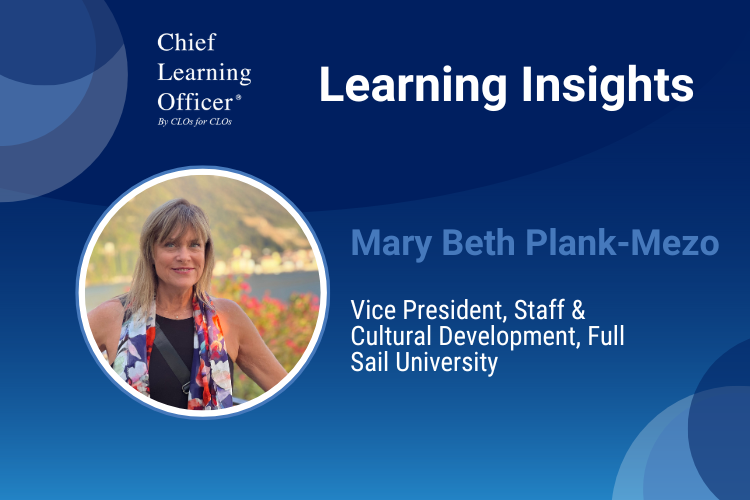Chief Learning Officer’s “Learning Insights” series is dedicated to showcasing the thoughts and career journeys of chief learning officers and learning executives — the tireless trailblazers who are transforming the landscape of corporate learning and workforce development. In this Q&A series, we garner strategic insights, innovative approaches and challenges overcome from visionary leaders worldwide.
What initially drew you to a career in L&D, and how have your experiences evolved over the years?
I moved into learning and development after spending 20-plus years leading the admissions department at Full Sail University in Winter Park, Florida.
I wanted to make a change in my career and focus more specifically on the employee journey, so I received a master’s degree in organizational leadership and got the opportunity to move into the role of vice president of staff and cultural development at Full Sail. I was able to create a new department that focused on the employee experience. Staff and cultural development, or SCD, serves employees from day one all the way through to retirement.
I’ve spent the past 10-plus years building systems, structures, and processes to help our employees and the organization learn, grow and thrive.
Over time, we’ve been able to build trust with employees and the C-suite which allowed us to build more and more programs to serve our employee population who in turn serve our students.
What key initiatives have you implemented as a learning leader to drive employee development and foster a learning culture?
Below are two programs that help us foster a learning culture:
Full Sail Leadership Academy: 3 levels of leadership
- Level 1: Ground School was developed to deliver entry-level training and alignment for all employees. The courses within Ground School—Supporting the Student’s Dream, Communications Essentials and Emotional Intelligence—provide the foundational customer service skills that are aligned with the university’s values (Guiding Principles). We also provide a course called Manager Basics for all new managers as they advance in their careers.
- Level 2: Navigator School is an application-based six-month leadership and development program for aspiring leaders. Applicants must receive supervisor approval to attend this six-month leadership development program. At the end of the program, aspiring leaders present their leadership portfolio to supervisors and executives and are encouraged to present innovative ideas and/or programs to enhance the university.
- Level 3: Flight School/Director’s Perspective Sessions, or DPS, are programs designed for higher-level leaders. DPS was birthed during the Pandemic to help directors navigate the new dynamics accompanied by the Pandemic. Directors from across the university come together to learn, grow, align and navigate the unprecedented and rapid changes through the COVID-19 pandemic with group coaching sessions.
The other initiative, the Women’s Leadership Initiative, or WLI, is designed to help women build their own leadership identity in a safe and confidential environment. We’ve found throughout the years that women need to know that there are others just like them struggling with lack of confidence, imposter syndrome and the ability to speak up in their careers. The program works to build self-confidence and awareness in a safe, all-female judgment-free zone as they practice networking, presenting and speaking up while being mentored by those who are further along in their career.
What is the most impactful learning program you’ve introduced in your organization, and how has it contributed to employee growth and business success?
That’s a tough question to answer, as many of these programs are life changers. I’m particularly proud of our staff development scholarship because a free education removes barriers for many employees, especially first-generation college students. I’ve seen many employees upgrade careers within the university as a result of this program.
I’ve also seen growth in aspiring female leaders through the Women’s Leadership Initiative. As a co-founder of the program, we designed the program in such a way that a passionate program participant may have the opportunity after completing the program to become a facilitator or leader in the program and finally, mentor other facilitators and leaders. It is a continuous learning and growth cycle for up-and-coming female leaders.
What is a common misconception people might have about the L&D function, and how do you address it?
The most common misconception we face is that employees don’t have time for development. Leaders and department heads may be reluctant to allow their employees to attend the highly beneficial development programs.
We certainly understand time is a precious resource. And of course, we share the life-changing stories told through employee feedback to overcome reluctant managers.
Separately, we try our best to accommodate department leaders by offering one-hour training sessions which are early in the day and include a meal (breakfast or lunch) so that the employee maximizes time in the office.
Ultimately, we must shift mindsets on a regular basis making sure leaders are aware of the benefits of investing in our most precious resource—our employees. Learning and growth are vital to employee retention and our business.
What excites you the most about the future of workplace learning, and how are you preparing your organization to adapt to the changing landscape?
We are trying to help prepare leaders to navigate volatility, uncertainty, complexity and ambiguity.
What essential qualities or skills make a successful L&D leader, and how do you cultivate these traits in yourself and among your team?
In my opinion, the most essential qualities are a passion for learning, tenacity in building systems, structures, and processes that benefit employees and the organization, and a belief in others as they navigate their own growth journey.
What game-changing advice would you offer if you could go back in time and mentor your younger self?
Everything you do is a learning opportunity. And: your defeats are the making of you. I am so proud of the many mistakes made in my career because they were all such wonderful learning opportunities. Now when implementing new products or programs we begin with a test program. This allows the team to explore, innovate and iterate new learning programs without the fear of failing.
What do you feel is currently the single biggest challenge facing L&D professionals and the industry as a whole?
The speed with which change is occurring is our biggest challenge. Also, I think AI could help speed up the designing, developing and delivering content.
We’re always looking to showcase innovative tools and technologies. Can you share one work or learning tech product or platform that has significantly improved your work processes and why you find it valuable?
Project management has been an issue for us in the past. We’ve used Trello, Monday.com, Workfront and other products. We’re currently working with Microsoft Project which seems to meet our needs.
Interested in being featured in our “Learning Insights” series? Please complete this FORM.















